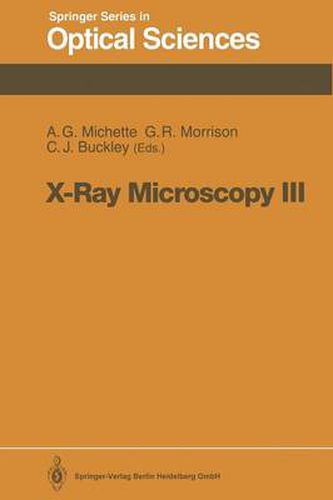Readings Newsletter
Become a Readings Member to make your shopping experience even easier.
Sign in or sign up for free!
You’re not far away from qualifying for FREE standard shipping within Australia
You’ve qualified for FREE standard shipping within Australia
The cart is loading…






This title is printed to order. This book may have been self-published. If so, we cannot guarantee the quality of the content. In the main most books will have gone through the editing process however some may not. We therefore suggest that you be aware of this before ordering this book. If in doubt check either the author or publisher’s details as we are unable to accept any returns unless they are faulty. Please contact us if you have any questions.
The growth of interest and research activity in X -ray microscopy is reflected in the increasing size and scope of a related series of international conferences, the latest of which (XRM90) was held at King’s College London (3-7 September 1990) with over 130 delegates. Previous conferences in Gottingen and Brookhaven resulted in books in the Springer Series in Optical Sciences, and this volume, the proceedings of XRM90, maintains this tradition. Because of the large number of papers their lengths were strictly limited and, while most papers can be directly identified with conference presentations, in a few cases those on similar topics by the same authors have been combined into a longer paper to allow better use of the space. The book is divided into six parts, with Parts IT-VI covering the major areas of interest at the conference. In Part 1 are two overviews; Ron Burge presented the opening paper of the conference, while the closing, summary, contrlbution by Janos Kirz is included here as a comprehensive introduction to the remainder of the book. Part IT covers developments in X -ray sources and optics. The high average brightnesses of synchrotron radiation sources have made many applications pos sible, while the more convenient, laboratory-based, plasma sources offer much promise for the future. Several contributions report significant advances in X-ray optics, which must clearly continue fully to exploit the latest sources.
$9.00 standard shipping within Australia
FREE standard shipping within Australia for orders over $100.00
Express & International shipping calculated at checkout
This title is printed to order. This book may have been self-published. If so, we cannot guarantee the quality of the content. In the main most books will have gone through the editing process however some may not. We therefore suggest that you be aware of this before ordering this book. If in doubt check either the author or publisher’s details as we are unable to accept any returns unless they are faulty. Please contact us if you have any questions.
The growth of interest and research activity in X -ray microscopy is reflected in the increasing size and scope of a related series of international conferences, the latest of which (XRM90) was held at King’s College London (3-7 September 1990) with over 130 delegates. Previous conferences in Gottingen and Brookhaven resulted in books in the Springer Series in Optical Sciences, and this volume, the proceedings of XRM90, maintains this tradition. Because of the large number of papers their lengths were strictly limited and, while most papers can be directly identified with conference presentations, in a few cases those on similar topics by the same authors have been combined into a longer paper to allow better use of the space. The book is divided into six parts, with Parts IT-VI covering the major areas of interest at the conference. In Part 1 are two overviews; Ron Burge presented the opening paper of the conference, while the closing, summary, contrlbution by Janos Kirz is included here as a comprehensive introduction to the remainder of the book. Part IT covers developments in X -ray sources and optics. The high average brightnesses of synchrotron radiation sources have made many applications pos sible, while the more convenient, laboratory-based, plasma sources offer much promise for the future. Several contributions report significant advances in X-ray optics, which must clearly continue fully to exploit the latest sources.